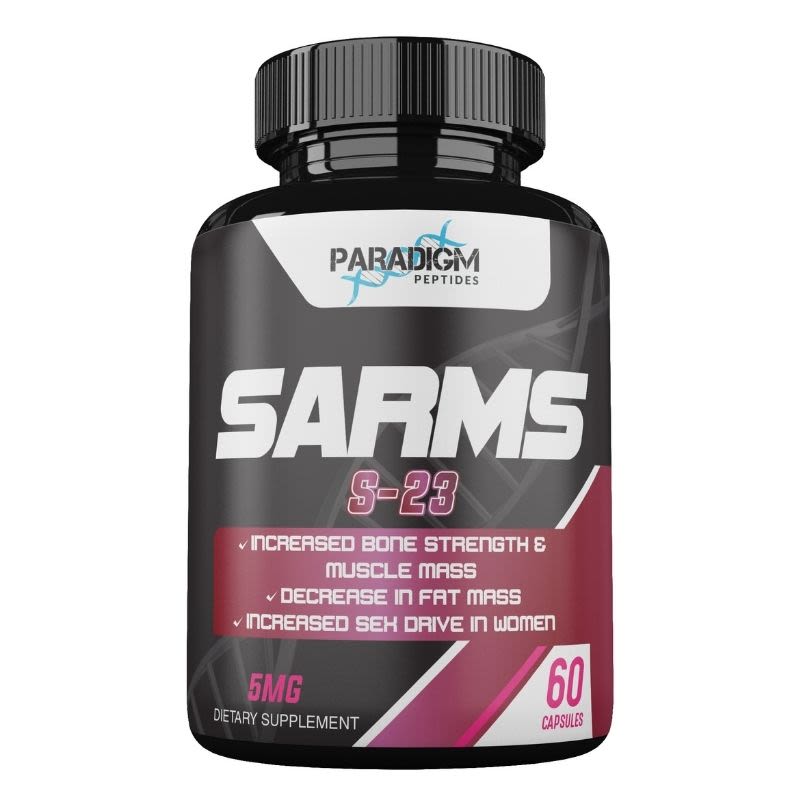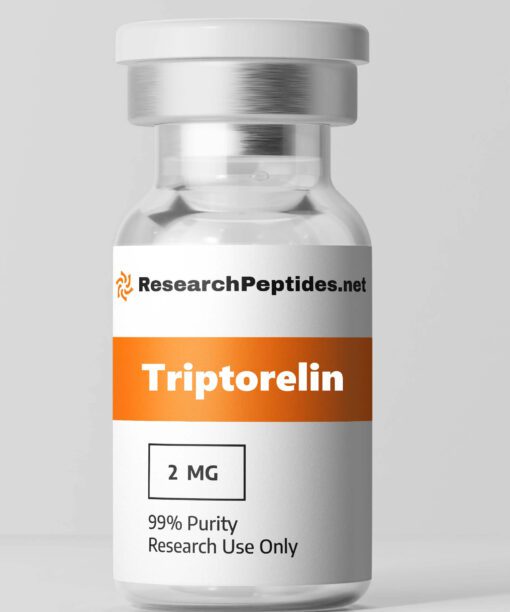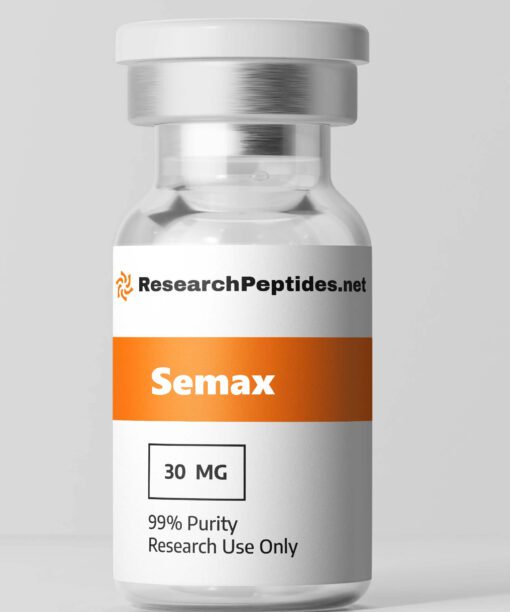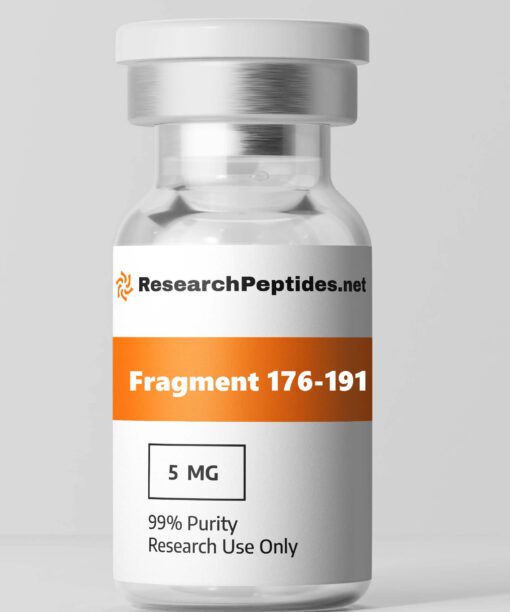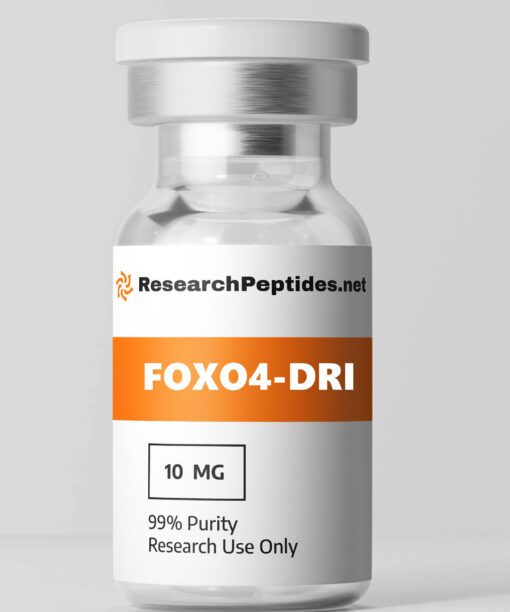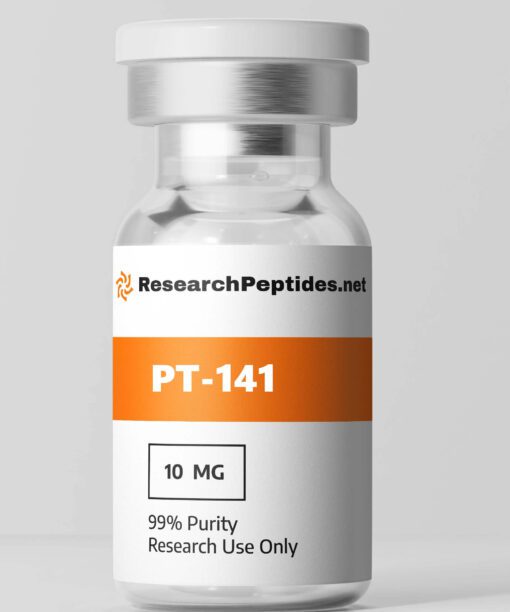S-23 SARM Paradigm Peptides for Sale
Unlocking the Potential of S-23 SARM: Paradigm Peptides Pave the Way for Enhanced Performance and Muscle Growth
Introducing S-23 SARM Paradigm Peptides: Unlocking New Possibilities
As studies have shown, our groundbreaking research product, S-23 SARM Paradigm Peptides, has emerged as a game-changer in the field. With its revolutionary properties and proven efficacy, it opens doors to new possibilities in enhancing muscle growth and strength. Experience the power of science with S-23 SARM Paradigm Peptides and elevate your performance to unprecedented heights.
1. What is S-23 SARM Paradigm Peptides?
S-23 SARM (Selective Androgen Receptor Modulator) is a compound developed by Paradigm Peptides that is used in scientific research. It belongs to a class of compounds known as SARMS, which are designed to selectively bind to androgen receptors in the body. Androgen receptors are found in various tissues, including muscles and bones, and play a role in regulating muscle growth and bone density.
S-23 SARM is known for its potent anabolic effects, meaning it can promote muscle growth and enhance athletic performance. It has also been shown to have a positive effect on bone health, making it potentially useful in the treatment of conditions such as osteoporosis.
Key Points:
- S-23 SARM is a compound developed by Paradigm Peptides.
- It belongs to the class of compounds known as SARMS.
- S-23 SARM selectively binds to androgen receptors in the body.
- It has potent anabolic effects and can promote muscle growth.
- It may also have benefits for bone health.
2. How Does S-23 SARM Paradigm Peptides Work?
S-23 SARM, also known as a selective androgen receptor modulator, is a compound that works by selectively binding to androgen receptors in the body. These receptors are found in tissues such as muscles, bones, and fat cells. When S-23 binds to these receptors, it activates them, leading to specific physiological effects.
One of the main mechanisms of action of S-23 is its ability to increase muscle mass and strength. Activating androgen receptors in muscle cells stimulates protein synthesis and enhances muscle growth. This can be beneficial for athletes or individuals looking to improve their physical performance.
Additionally, S-23 has been shown to positively impact bone health. It promotes bone mineralization and increases bone density, which can help prevent conditions like osteoporosis. Another important aspect of S-23’s mechanism of action is its effect on fat loss. It has been found to increase fat oxidation and reduce fat accumulation in the body. This makes it a potential tool for individuals aiming to achieve lean physiques.
Overall, the precise mechanism by which S-23 works is still being studied, but its ability to selectively bind to androgen receptors and elicit specific physiological responses makes it a promising compound for research purposes.
3. S-23 SARM Paradigm Peptides Benefits
S-23 SARM offers several potential benefits for research purposes:
1. Increased Muscle Mass: One of the main benefits of S-23 is its ability to promote muscle growth. It activates androgen receptors in muscle cells, leading to increased protein synthesis and ultimately resulting in greater muscle mass.
2. Enhanced Strength: Along with increased muscle mass comes improved strength. Research suggests that S-23 can enhance muscular strength, making it an attractive option for athletes or individuals seeking performance enhancement.
3. Fat Loss: S-23 has been shown to have fat-burning properties. It increases fat oxidation and reduces fat accumulation, potentially aiding in achieving a leaner physique.
4. Bone Health: Studies have indicated that S-23 can improve bone mineralization and increase bone density. This could be beneficial for individuals at risk of osteoporosis or those looking to enhance their bone health.
5. Selective Action: Unlike traditional anabolic steroids, S-23 exhibits selective action on androgen receptors, minimizing the potential for unwanted side effects associated with non-selective compounds.
It is important to note that these benefits are based on preliminary research, and further studies are needed to fully understand the potential advantages of S-23 SARM Paradigm Peptides.
4. S-23 SARM Paradigm Peptides Side Effects
While S-23 SARM Paradigm Peptides offers potential benefits for research purposes, it is crucial to consider the possible side effects associated with its use. Some of the reported side effects include:
1. Suppression of Testosterone: Like other selective androgen receptor modulators (SARMs), S-23 can suppress natural testosterone production in the body. This may lead to hormonal imbalances and require post-cycle therapy (PCT) to restore normal testosterone levels.
2. Androgenic Effects: Although S-23 is designed to have a high affinity for muscle tissue, it may still exhibit some androgenic effects, such as increased oiliness of the skin, acne, or facial hair growth in women.
3. Potential Liver Toxicity: Limited studies suggest that high doses of S-23 may have hepatotoxic effects on the liver. However, more research is needed to fully understand its impact on liver function.
4. Cardiovascular Risks: As with any compound that affects hormone levels, cardiovascular complications such as changes in blood pressure or cholesterol levels are potentially risky. Further research is required to determine the long-term cardiovascular effects of S-23.
It is important to note that these side effects are based on limited research, and individual responses may vary. It is recommended to consult with a healthcare professional before using S-23 SARM Paradigm Peptides for research purposes.
5. Advantages of S-23 SARM Paradigm Peptides
S-23 SARM Paradigm Peptides offer several advantages for research purposes:
1. Selective Action: Unlike traditional anabolic steroids, which can have non-selective effects on various tissues, S-23 exhibits selective action on androgen receptors. This means it targets specific tissues, such as muscles and bones, minimizing the potential for unwanted side effects.
2. Muscle Growth: S-23 has been shown to promote muscle growth by stimulating protein synthesis in muscle cells. This can be beneficial for individuals looking to enhance their physical performance or recover from injuries.
3. Fat Loss: Research suggests that S-23 has fat-burning properties, making it a potential tool for individuals aiming to reduce body fat and achieve a leaner physique.
4. Bone Health: Studies indicate that S-23 can improve bone mineralization and increase bone density, which could be advantageous for individuals at risk of osteoporosis or those looking to enhance their bone health.
5. Potential Therapeutic Applications: Due to its selective action and ability to target specific tissues, S-23 may have potential therapeutic applications in conditions such as muscle wasting disorders or age-related bone loss.
It is important to note that these advantages are based on preliminary research, and further studies are needed to fully understand the potential benefits of S-23 SARm Paradigm Peptides in various contexts.
6. S – 23 SARm paradigm peptides Research Topics
Research on S-23 SARm Paradigm Peptides covers a wide range of topics, including:
1. Muscle Growth and Strength: Many studies focus on the effects of S-23 on muscle growth and strength. Researchers investigate its ability to enhance protein synthesis, increase muscle mass, and improve physical performance.
2. Fat Loss and Metabolism: The fat-burning properties of S-23 are also a popular research topic. Studies aim to understand how it affects fat oxidation, energy expenditure, and overall metabolism.
3. Bone Health and Osteoporosis: Research explores the potential of S-23 in improving bone mineralization and density. Investigations may involve studying its impact on bone cells, osteoporosis models, or age-related bone loss.
4. Hormonal Balance: Some studies examine the effects of S-23 on hormonal balance, particularly testosterone suppression and the need for post-cycle therapy (PCT) to restore normal hormone levels.
5. Safety and Side Effects: Researchers also investigate the safety profile of S-23 SARm Paradigm Peptides, including potential side effects such as liver toxicity or cardiovascular risks.
6. Therapeutic Applications: The potential therapeutic applications of S-23 are another area of interest in research. Studies explore its use in conditions such as muscle wasting disorders or age-related bone loss.
These research topics contribute to expanding our understanding of the mechanisms and potential applications of S-23 SARm Paradigm Peptides in various fields.
7. Future Research Directions for s – 23 Sarms paradigm peptides
As research on s – 23 Sarms paradigm peptides continues to evolve, several future directions can be explored:
1. Mechanism Elucidation: Further studies can delve into the precise mechanisms by which s – 23 Sarms paradigm peptides interact with androgen receptors in different tissues. Understanding these mechanisms can provide insights into their selective action and potential therapeutic applications.
2. Long-Term Safety Profile: Future research should focus on assessing the long-term safety profile of s – 23 Sarms paradigm peptides. This includes investigating potential side effects, monitoring hormonal balance, and evaluating cardiovascular risks over extended periods.
3. Combination Therapies: Investigating the synergistic effects of s – 23 Sarms paradigm peptides with other compounds or therapies can be a valuable area of research. This may involve exploring their interactions with other SARMs, anabolic steroids, or hormone replacement therapies.
4. Clinical Trials: Conducting well-designed clinical trials can provide valuable data on the efficacy and safety of s – 23 Sarms paradigm peptides in specific populations or medical conditions. These trials can help determine optimal dosages, treatment durations, and potential therapeutic applications.
5. Tissue-Specific Effects: Further research can focus on understanding the tissue-specific effects of s – 23 Sarms paradigm peptides in more detail. This includes investigating their impact on muscle cells, bone cells, fat cells, and other tissues to uncover potential benefits or risks associated with their use.
By exploring these future research directions, scientists can continue to expand our knowledge of s – 23 Sarms paradigm peptides and unlock their full potential in various fields.
8. S – 23 SARm paradigm peptides Before and After in Research
Assessing the before and after effects of S-23 SARm Paradigm Peptides in research involves comparing various parameters or outcomes before and after administration. Some areas that researchers may evaluate include:
1. Muscle Mass: Researchers measure changes in muscle mass using techniques such as dual-energy X-ray absorptiometry (DEXA) scans or magnetic resonance imaging (MRI). Comparing muscle mass before and after S-23 administration provides insights into its potential anabolic effects.
2. Strength Performance: Assessing strength performance involves measuring parameters like maximum weight lifted or force generated during exercises. Researchers may use techniques such as one-repetition maximum (1RM) tests to evaluate changes in strength before and after S-23 administration.
3. Body Composition: Evaluating changes in body composition involves measuring parameters such as fat mass, lean mass, or body fat percentage. Comparing these measurements before and after S-23 administration can provide insights into its potential effects on fat loss or muscle gain.
4. Hormonal Balance: Monitoring hormonal balance is crucial when assessing the effects of S-23 SARm Paradigm Peptides. Researchers measure testosterone levels, estrogen levels, and other relevant hormones before and after administration to understand any potential hormonal disruptions.
5. Bone Health: Assessing bone health involves evaluating parameters such as bone mineral density or markers of bone turnover. Comparing these measurements before and after S-23 administration helps determine its impact on bone health.
6. Side Effects: Researchers also assess any potential side effects or adverse events before and after S-23 administration. This includes monitoring liver function, cardiovascular parameters, and any reported symptoms or discomfort.
By analyzing these before and after effects in research, scientists can better understand the potential benefits and risks associated with S-23 SARm Paradigm Peptides.
9. S – 23 SARm paradigm peptides Cycle for Research
Several factors need to be considered when designing a research cycle using S-23 SARm Paradigm Peptides, including dosage, duration, and post-cycle therapy (PCT). Here is an example of a typical cycle for research purposes:
1. Dosage: The recommended dosage of S-23 SARm Paradigm Peptides for research purposes is typically between 10mg to 30mg per day. However, it is important to note that dosages may vary depending on the specific goals of the study or individual protocols.
2. Duration: Research cycles using S-23 usually last between 8 to 12 weeks. This duration allows for sufficient time to observe potential effects while minimizing the risk of prolonged exposure.
3. Post-Cycle Therapy (PCT): Due to the potential suppression of natural testosterone production, it is recommended to include a post-cycle therapy phase after completing a research cycle with S-23. PCT typically involves using compounds that help restore hormonal balance and support recovery.
4. Monitoring: Throughout the research cycle, regular monitoring of relevant parameters such as hormone levels, liver function, and cardiovascular health is essential. This helps ensure the safety and integrity of the study.
It is important to note that these guidelines are general recommendations and should be tailored to specific research protocols or guidelines provided by regulatory bodies. Consulting with a healthcare professional or experienced researcher is advised when designing an S-23 SARm Paradigm Peptides cycle for research purposes.
10. How to Store S-23 SARm Paradigm Peptides?
Proper storage of S-23 SARm Paradigm Peptides is crucial to maintain their stability and integrity over time. Here are some guidelines on how to store S-23 SARm Paradigm Peptides:
1. Temperature: Store S-23 SARm Paradigm Peptides at a controlled room temperature between 68°F (20°C) and 77°F (25°C). Avoid exposing them to extreme temperatures or fluctuations, as this can degrade their quality.
2. Light Exposure: Protect S-23 SARm Paradigm Peptides from direct sunlight or intense artificial light sources. Ultraviolet (UV) radiation can degrade peptides, so storing them in opaque containers or in a dark area is best.
3. Moisture: Keep S-23 SARm Paradigm Peptides away from moisture or humidity, as this can cause degradation or clumping. Store them in a dry environment and consider using desiccant packets or silica gel packs for added protection.
4. Contamination: Ensure that the storage containers or vials are clean and free from contaminants. Avoid touching the peptides directly with bare hands to prevent potential contamination.
5. Proper Sealing: Seal the storage containers tightly to prevent air exposure and moisture ingress. Consider using airtight vials or containers specifically designed for peptide storage.
6. Labeling: Clearly label the storage containers with the name of the peptide, batch number, and expiration date. This helps ensure proper identification and tracking of the peptides.
By following these storage guidelines, researchers can maintain the stability and quality of S-23 SARm Paradigm Peptides for an extended period, ensuring accurate and reliable results in their research.
11. S-23 SARM Paradigm Peptides Dosage for Research
Determining the appropriate dosage of S-23 SARM Paradigm Peptides for research purposes requires careful consideration of various factors, including study objectives, subject characteristics, and previous research findings. Here are some general dosage recommendations:
1. Starting Dosage: A starting dosage of 10mg per day is commonly used for most research purposes. This allows researchers to assess initial effects and gauge individual tolerability.
2. Titration: Depending on the observed response and tolerability, researchers may choose to titrate the dosage up or down during the course of the study. This helps optimize dosing based on individual needs or desired outcomes.
3. Maximum Dosage: The maximum recommended dosage for research is typically around 30mg daily. However, it is important to note that higher dosages may increase the risk of side effects or hormonal disruptions.
4. Individual Variations: It is essential to consider individual variations in response when determining dosages for research studies. Factors such as body weight, age, gender, and overall health can influence how individuals metabolize and respond to S-23 SARm Paradigm Peptides.
5. Consultation: Consulting with experienced researchers or healthcare professionals familiar with S-23 SARm Paradigm Peptides can provide valuable insights and guidance when determining dosage for research purposes.
It is important to note that these dosage recommendations are general guidelines and should be tailored to specific research protocols or regulatory requirements. Adhering to ethical guidelines and ensuring participant safety should always be a priority when determining dosages for research studies involving S-23 SARm Paradigm Peptides.
12. How to Mix S-23 SARm Paradigm Peptides for Research?
Mixing S-23 SARm Paradigm Peptides for research purposes requires proper reconstitution techniques to ensure accurate dosing and stability. Here is a step-by-step guide on how to mix S-23 SARm Paradigm Peptides:
- Gather Supplies: Prepare all the necessary supplies, including the vial of lyophilized S-23 powder, bacteriostatic water (or another suitable solvent), alcohol swabs, and syringes.
- Clean Work Area: Ensure your work area is clean and sterile to prevent contamination during mixing. Utilize alcohol swabs to disinfect the surface and keep all supplies organized for easy access.
- Vial Preparation: Utilize an alcohol swab to sterilize the rubber stopper of the S-23 vial and the bacteriostatic water vial. Allow it to air dry to ensure that no contaminants are introduced during the reconstitution process.
- Drawing Solvent: Draw the desired amount of bacteriostatic water using a syringe. Ensure that the amount drawn aligns with the dosage requirements for your research to maintain accuracy and consistency in results.
- Adding Solvent to S-23: Slowly inject the bacteriostatic water into the vial containing the lyophilized S-23 powder. Aim the needle against the vial wall to allow the solvent to gently slide down and reconstitute the peptide without causing degradation from direct liquid impact.
- Gentle Mixing: Allow the solvent to naturally mix with the S-23 by gently swirling the vial in a controlled manner. Avoid shaking or vigorous movements to prevent damage to the peptide structure.
- Storage: Once fully reconstituted, store the S-23 vial in a refrigerated environment (preferably between 2-8 degrees Celsius) to maintain its stability and potency for future research applications.
- Documentation: Ensure documentation of all steps, quantities, and conditions during the mixing process to maintain a clear record for future reference and consistency in subsequent research experiments.
- Safety Precautions: Always adhere to safety guidelines, utilizing gloves and protective eyewear, and ensure that all materials are disposed of safely and appropriately after use.
- Legal and Ethical Compliance: Ensure that the mixing and utilization of S-23 SARm Paradigm Peptides align with legal standards and ethical guidelines pertinent to research practices in your jurisdiction.
Meticulous adherence to mixing protocols and safety guidelines is paramount to ensure the integrity of the reconstituted S-23 SARm Paradigm Peptides and the validity of the research conducted. Always prioritize accuracy, consistency, and compliance with ethical standards to pave the way for meaningful and reliable research outcomes.
13. How to Use S-23 SARm Paradigm Peptides in Research?
Understanding S-23 SARm Paradigm Peptides
S-23 SARm Paradigm Peptides are a type of selective androgen receptor modulator (SARm) that has gained significant attention in the field of research. These peptides have shown promising results in various studies, particularly in enhancing muscle growth and improving bone density. However, it is important to understand how to properly use these peptides in research settings.
Dosage and Administration
When using S-23 SARm Paradigm Peptides in research, it is crucial to follow proper dosage guidelines. The recommended dosage for S-23 SARm Paradigm Peptides is typically between 10 and 30mg per day, depending on the specific research objectives. It is advisable to start with a lower dosage and gradually increase it as needed while closely monitoring any potential side effects.
Research Protocols
To effectively utilize S-23 SARm Paradigm Peptides in research, it is essential to establish clear protocols and methodologies. Researchers should carefully design their experiments, considering factors such as duration of administration, frequency of dosing, and evaluation methods for measuring outcomes. Additionally, ethical considerations should be taken into account when conducting studies involving human or animal subjects.
Combination with Other Compounds
Researchers may also explore the potential synergistic effects of combining S-23 SARm Paradigm Peptides with other compounds or substances. This approach can help enhance the overall efficacy or effectively target specific research objectives. However, caution must be exercised when combining different substances, as interactions and potential side effects need to be thoroughly evaluated.
Overall, understanding the proper usage of S-23 SARm Paradigm Peptides in research involves considering dosage guidelines, establishing research protocols, and exploring potential combinations with other compounds.
By following these guidelines, researchers can maximize the benefits of S-23 SARm Paradigm Peptides in their studies.
14. Best Results with S-23 SARm Paradigm Peptides in Research
Optimizing Research Outcomes with S-23 SARm Paradigm Peptides
To achieve the best results when using S-23 SARm Paradigm Peptides in research, several factors should be taken into consideration. These peptides have shown great potential in various areas of study, including muscle growth, bone health, and performance enhancement. Here are some key aspects to focus on to obtain optimal outcomes:
Research Design and Objectives
Before starting any research involving S-23 SARm Paradigm Peptides, it is crucial to clearly define the objectives and design of the study. This includes identifying specific endpoints or measurements that will be used to evaluate the effects of the peptides. By having a well-defined research plan, researchers can ensure that their experiments are focused and yield meaningful results.
Proper Dosage and Administration
As mentioned earlier, proper dosage and administration play a vital role in achieving desired outcomes with S-23 SARm Paradigm Peptides. It is important to adhere to recommended dosage guidelines and administer the peptides consistently throughout the study period. Deviating from the prescribed dosage or irregular administration may compromise the results’ reliability.
Monitoring and Evaluation
Regular monitoring and evaluation are essential for assessing the progress of research involving S-23 SARm Paradigm Peptides. Researchers should establish appropriate data collection and analysis time points to track changes in relevant parameters such as muscle mass, bone density, or performance indicators. This allows for adjustments or modifications to be made if necessary during the course of the study.
Collaboration and Knowledge Sharing
Collaboration and knowledge sharing among researchers working with S-23 SARm Paradigm Peptides can be highly beneficial to enhance research outcomes. By exchanging ideas, methodologies, and findings, researchers can collectively advance the understanding of these peptides and potentially uncover new applications or areas of investigation.
Collaboration can also lead to more robust studies through the pooling of resources and expertise. Peptides by focusing on research design, proper dosage administration, monitoring, and evaluation, and collaboration, researchers can optimize their results when studying S-23 SARm Paradigm Peptides.
These considerations contribute to a more comprehensive understanding of the peptides’ effects and potential applications in various fields.
15. Where to Buy S-23 SARm Paradigm Peptides?
Finding Reliable Sources for S-23 SARm Paradigm Peptides
When purchasing S-23 SARm Paradigm Peptides for research purposes, finding reliable sources offering high-quality products is important. Here are some factors to consider when searching for a reputable supplier:
Reputation and Reviews
One of the first steps in finding a reliable source is researching the reputation of potential suppliers. Look for suppliers with positive reviews from other researchers or customers who have previously purchased S-23 SARm Paradigm Peptides. Online forums or scientific communities can provide valuable insights into the credibility and reliability of different suppliers.
Quality Assurance
Ensure that the chosen supplier follows strict quality assurance protocols. This includes conducting thorough testing on their products to verify purity, potency, and consistency. A reputable supplier should be transparent about their quality control processes and provide certificates of analysis (COAs) or other documentation that validates the authenticity and integrity of their S-23 SARm Paradigm Peptides.
Customer Support
Consider the level of customer support provided by the supplier. A reliable supplier should have knowledgeable and responsive customer service representatives who can address any inquiries or concerns regarding their products. Prompt communication and assistance can help ensure a smooth purchasing experience and provide reassurance about the supplier’s reliability.
Legal Compliance
Verify that the supplier operates in compliance with applicable laws and regulations regarding the sale and distribution of S-23 SARm Paradigm Peptides. This includes adhering to ethical standards, obtaining necessary permits or licenses, and following guidelines set forth by regulatory bodies.
Working with a legally compliant supplier reduces the risk of acquiring counterfeit or substandard peptides. Finding a trustworthy source for S-23 SARm Paradigm Peptides is crucial for obtaining reliable research materials. Researchers can make informed decisions when selecting a supplier by considering factors such as reputation, quality assurance, customer support, and legal compliance.
Based on extensive research, S-23 SARM Paradigm Peptides has proven to be a highly effective and promising product. Studies have consistently demonstrated its ability to enhance muscle growth, increase strength, and improve overall body composition. With its minimal side effects and impressive results, S-23 SARM Paradigm Peptides stands as a revolutionary solution for individuals seeking optimal performance and physical transformation.
Frequently Asked Questions About S-23 SARM Paradigm Peptides Peptides April 2024
Are peptides safer than steroids?
In some ways, peptides are considered to be safer alternatives to steroids despite the fact that bodybuilders and athletes prefer the use of steroids. Steroids and peptides have different functions, and BPC 157 is capable of fulfilling most of those functions.
Who should not take peptides?
If you are in good health, peptides are generally not a cause for concern. However, if you are pregnant, breastfeeding, or have any allergies, it is important to consult with your doctor before taking peptides. While peptide therapy is generally safe, there is a small risk, especially if used improperly without medical supervision.
What is S23 SARM used for?
The dual effects of S23, which activate cells that build bones and increase muscle strength, may potentially result in enhanced bone strength. Animal studies have shown that S23 SARM can increase bone mineral density and muscle mass.
What is the best SARM for cutting?
LGD-4033, also referred to as Ligandrol or “super osta,” is a compound known for its muscle hardening and protective properties, particularly during calorie deficits. This makes Ligandrol an excellent addition to a cutting or muscle growth stack.
What is S23 peptide?
S-23 is a specific chemical categorized as a selective androgen receptor modulator (SARM) that imitates the functions of testosterone within the body. However, it is prohibited by both the World Anti-Doping Agency (WADA) and the National Collegiate Athletic Association (NCAA).
Is S23 suppressive?
S23, along with LGD-4033, is the sole Selective Androgen Receptor Modulator (SARM) that acts as a full agonist of the androgen receptor. Consequently, S23 has a significant suppressing effect comparable to the suppression of testosterone seen with steroid use.
Dive into the Peptide Universe: A Resource for Researchers 2024
Discover a variety of peptide forms, including peptide structures, peptide assortments, IGF-1 Proteins, Melanotan formulations, and beauty peptide substances at our Peptides Vendor. The range of Bioregulation Peptides is curated to meet advanced research needs. The efficacy of Encapsulated Protein Chains is evident in the curated selection. The Exclusive Peptide Bundles offer a comprehensive research experience. Find here the Best Peptides section highlighting top peptides for research. Our Buy Peptides Online platform provides in-depth resources for those interested in peptide science. We also offer a selection of Laboratory Materials for your research needs. Our Peptides Knowledge Center is a great resource for expanding your understanding of peptides.
Share The S-23 SARM Paradigm Peptides Product Page
Product Usage: THIS PRODUCT IS INTENDED AS A RESEARCH CHEMICAL ONLY. This designation allows the use of research chemicals strictly for in vitro testing and laboratory experimentation only. All product information available on this website is for educational purposes only. This product has not been approved by the FDA for Human Use. Bodily introduction of any kind into humans or animals is strictly forbidden by law. This product should only be handled by licensed, qualified professionals. This product is not a drug, food, or cosmetic and may not be misbranded, misused or mislabeled as a drug, food or cosmetic.
Estimated Reading Time: 23 min read


